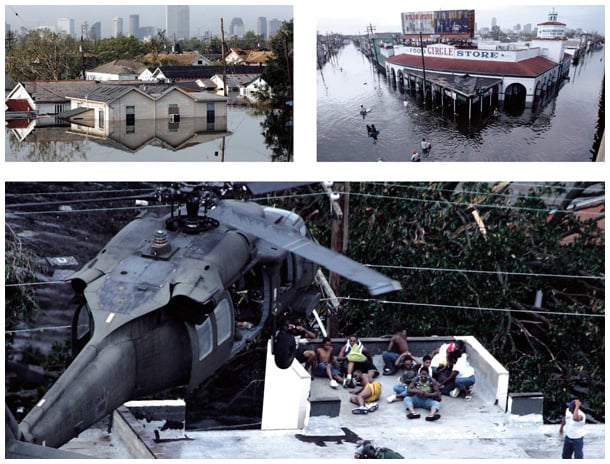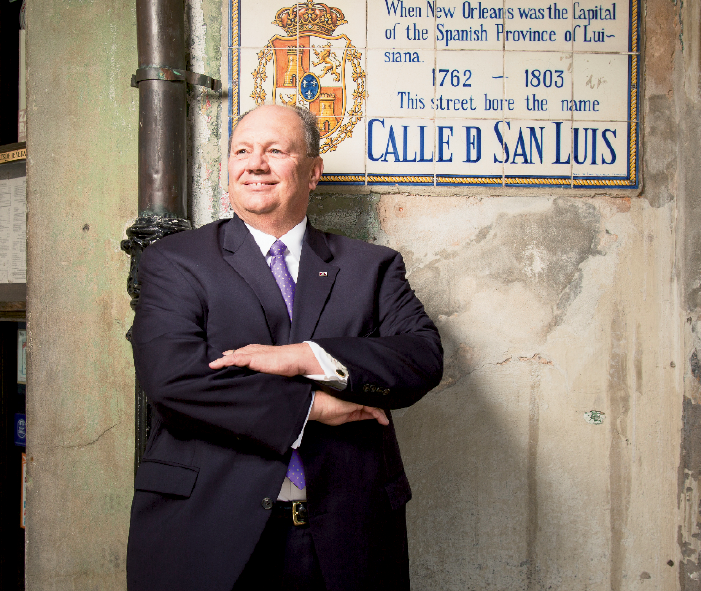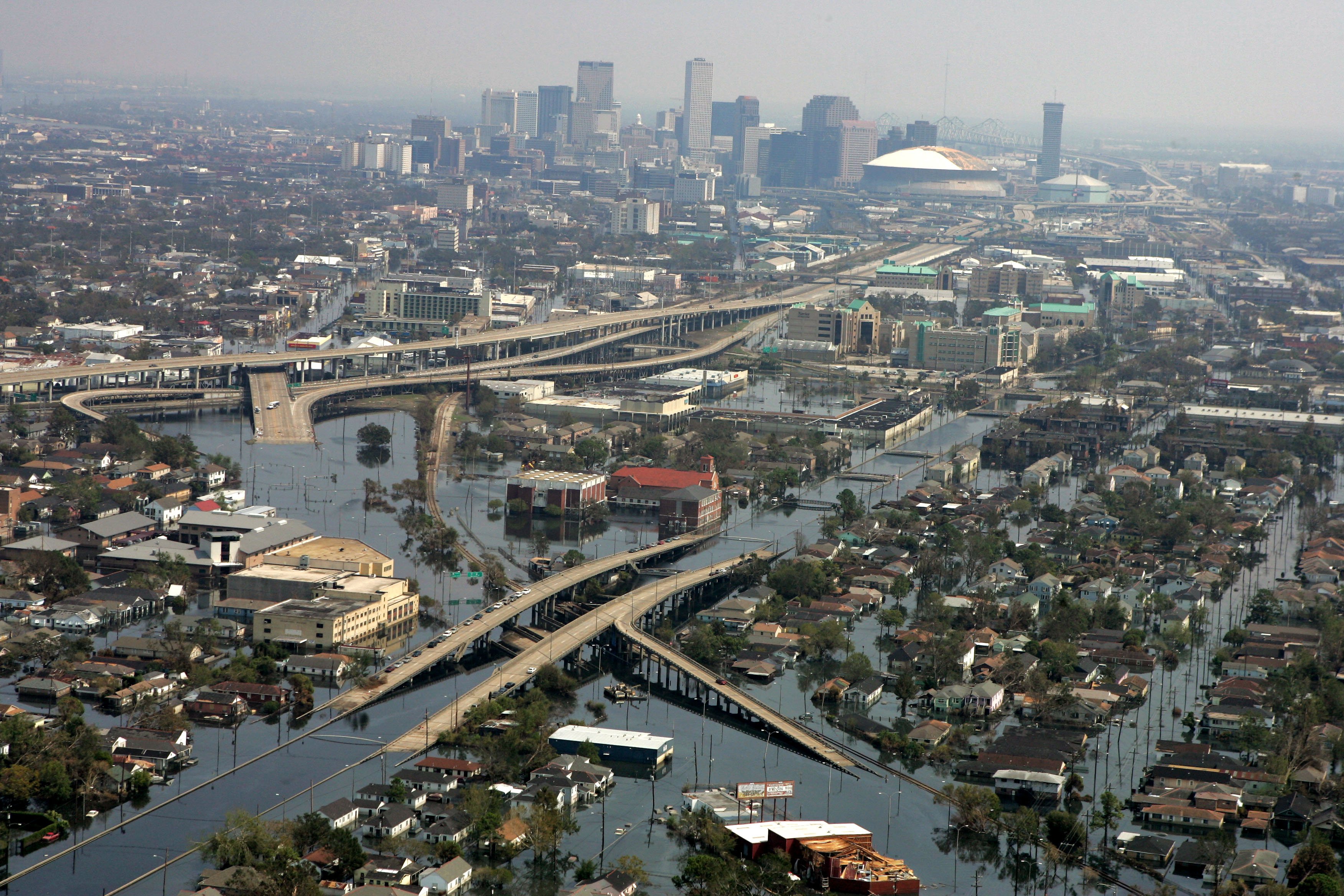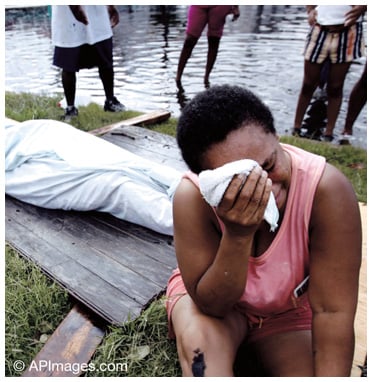This city won't wash away
This city won't ever drown
Blood in the water and hell to pay
Sky tear open and pain rain down
Doesn't matter, 'cause come what may
I ain't ever going to leave this town
This city won't wash away …
This city won't ever drown.
— “This City,” Steve Earle
A right turn onto a residential street in Gentilly, a middle-class neighborhood typical of so many like it in this country, reveals a secret hidden in plain sight—one that reflects the stark contrast between lives reclaimed and lives lost.
It's quiet, which isn't uncommon at this time of the morning. Most folks who live here are at work or school. Proud, working-class homes dot the street, sporting fresh paint, new roofs and well-manicured lawns.
Yet something is missing.
It's found in the spaces you suddenly notice between the houses, the gaps that separate these individual pockets of humanity.
Our driver and tour guide parks his truck and we step out onto the street, where the reality of life in New Orleans a decade after Hurricane Katrina is brought into sharp focus—and it hits you like a hammer that a family once lived here, in this 50-foot-wide lot where a house once stood.
Not even the concrete slabs upon which these houses are built remain; just an empty lot now reclaimed by St. Augustine grass. The only telltale sign is the address, spray-painted in yellow on the curb.
This area was hit hard 10 years ago during Hurricane Katrina, when floodwaters breached the walls of the London Avenue Canal and poured in, relentlessly pushing countless homes past the point of reclamation. Across the entire city, the storm's impact is still felt. Time will not erase it—certainly not only 10 years' time.
“I don't know if you ever get over it,” says Richie Clements, his tone resigned. “I don't know if you should.”
The current national president of the National Association of Professional Insurance Agents (PIA) and an insurance man since the mid-'70s, Clements forged a new agency out of the ashes of the worst natural disaster ever to be visited upon U.S. soil, and in the process, multiplied his premium volume—and his own professional satisfaction—several times over. Once a co-principal at an agency he shared with a former partner, Clements now is the leader of Clements Insurance Services in Chalmette, La., where his two sons also serve as producers and where he keeps his eye fixed on his agency's continued growth.
Here, locals refer to Katrina as “the storm.” In the days and weeks of its aftermath, people had the same question for their friends and neighbors: “How'd you do?” Not a single person was left unscarred. If you didn't lose something precious, someone close to you did. Clements was no exception.
These days, New Orleans is a mixed cocktail of inspiring recovery and permanent ruin. Some neighborhoods that were inundated with 12 feet of water have since become prime real estate. New, gorgeous schools paid for with FEMA funds and some very reasonable prices for property are attracting families from other areas of the country.
“This is the best place in the universe,” Clements says without an ounce of hyperbole, as he steers us through the steadily recovering area of Lakeview. On every other street, it seems, another new home is going up or being refurbished. All have one thing in common: They're being built to new elevations, another example of the “new normal” in this steadily rebounding town.
Coming so close to losing the city's vibrant culture—the history, the music, the cuisine, all that makes New Orleans so unique—made people appreciate it more, Clements says. “Before, we just kind of lived here.”
There is no separating the story of New Orleans' revitalization efforts from Clements' own tale. His story is a microcosm of the struggle shared by all of the area's residents—of the Big Easy's greater desire to rebuild upon what was lost, to discover a new way of living, to wring opportunity out of devastation.
Still as bold and sassy as the town he proudly calls home, Clements is a survivor. He's not going anywhere.
LESSONS LEARNED
 “This is what insurance policies look like from a flooded home,” says Clements, as he brandishes a crusty, brittle stack of papers in his modest office in St. Bernard Parish. Like so many things that were left permanently altered by Katrina, they are stained with brown watermarks. They also whisper of tangible hope pulled from scenes of utter loss—of a chance for insurers to help their clients regain at least some semblance of normalcy.
“This is what insurance policies look like from a flooded home,” says Clements, as he brandishes a crusty, brittle stack of papers in his modest office in St. Bernard Parish. Like so many things that were left permanently altered by Katrina, they are stained with brown watermarks. They also whisper of tangible hope pulled from scenes of utter loss—of a chance for insurers to help their clients regain at least some semblance of normalcy.
Clements remembers that period of his life well, a dark slice of time in which he discovered what being part of the insurance industry was truly all about.
He thought he'd learned it, of course, in his more than 20 years in the business—a journey begun in March 1974, when after graduating from Nicholls State University in Thibodaux, La., he took a job selling burial policies for the Schoen Funeral Home in Covington. For more than a year he visited insureds' homes and collected their premiums—almost always forked over in cash—and often politely staying for a spell to enjoy a cup of coffee or a piece of cake.
After taking a life underwriter's training course about a year later, he says, “I learned what real life insurance was, as opposed to the stuff that I was selling.” That same year, he got married and went to work for Prudential Financial. “They had gone into property & casualty in '75, so I started doing more P&C than life,” he recalls. “After a couple of years, it just got to a point where I wanted the ownership of the business as opposed to being a direct employee.”
In January 1978 he partnered with fellow Prudential agent Chris Eslava to co-found the Eslava and Clements Insurance Agency, a full-lines office where they first wrote policies in a single room, mostly P&C cover. They piggybacked on each other's strengths and built the business up to a point at which they needed an additional eight employees.
While the agency did dabble in life products, he preferred selling P&C. He still does. “I got into Property & Casualty because if you own a house, you've probably got a mortgage,” he says. “Life policies are a harder sell. I wanted to concentrate my efforts where I could make a better living.”
By the summer of 2005, however, Clements felt that partnership had run its course. He wanted out, in order to aggressively pursue more business on his own. Little did he know that the transformation he was looking for would change far more than his agency's address.
RIDERS ON THE STORM
 On Friday night, Aug. 26, 2005, Clements sat in the stands at the Louisiana Superdome, sipping an $8 Bud Light “Dome Foam,” watching the New Orleans Saints play the Baltimore Ravens in a preseason game. It would be the last time the team would suit up at home that season.
On Friday night, Aug. 26, 2005, Clements sat in the stands at the Louisiana Superdome, sipping an $8 Bud Light “Dome Foam,” watching the New Orleans Saints play the Baltimore Ravens in a preseason game. It would be the last time the team would suit up at home that season.
Clements' office had been tracking an offshore storm system that only seemed to loom larger by the day. At halftime, a stranger sitting next to him passed word that it was headed for Florida. “I said, 'Oh no, this thing is huge. Those poor people in Pensacola are going to get it again. I really feel bad for them, that they get hit so often.'”
By 7 a.m. Central Standard Time the next day the storm had shifted course, however, and New Orleans residents were ordered to evacuate. Contraflow lane reversal, in which all lanes of traffic are routed out of the city, was put into effect to aid in the heavy flow of automobiles heading out of town.
Clements' wife, Charmaine, needed no prodding. As a child, she suffered the harrowing experience of riding out Hurricane Betsy with her family in an attic as her neighborhood flooded, and escaped through the roof as the waters rose. She could hear the distant cries of neighbors who were trapped and drowned inside their own attics, unable to punch through.
Forever afterward, every time the call came to get out of a storm's path, she didn't hesitate.
Yet Clements—and a good many others—didn't panic. The storm was expected to do some serious damage in some areas, but not hit the city at maximum impact. The Clementses expected to be inconvenienced for a few days at best. They'd visit their sons Tim and David, and ride out the storm in the boys' off-campus apartment near Louisiana State University in Baton Rouge.
Clements ran down to the office, boarded up the windows and covered the computers with garbage bags. On his way out—and he admits he still isn't sure what led him to do it—he took the office's file server and two desktop computers. Acting on the advice of the PIA, the agency had imaged every client's declaration page; he figured he'd at least have those with him, and they could contact clients when they got back.
The Clementses packed clothes and provisions for three days, boarded up the shutters, grabbed their Shih Tzu, Tillie, and hit the road around 4 p.m. in Charmaine's SUV, leaving their brand-new Infiniti behind.
Hours later, spirits were high in Baton Rouge. Clements' in-laws were there with their two dogs, his sister-in-law arrived with her two children and dog, and the cooking began, the group making the best of all the food brought that would have spoiled back at home in refrigerators robbed of electricity.
By Sunday morning, the storm had strengthened to a Category 5 hurricane. After weakening slightly, Katrina finally made landfall in Louisiana at around 6 a.m. on Monday, Aug. 29, as a Category 3 storm packing 127-mph winds. Its storm surge caused 53 separate levee breaches in greater New Orleans, placing 80% of the city under water.
The devastation visited upon Louisiana was unprecedented in U.S. history, and remains unmatched. All told, nearly 1,600 people died in Louisiana alone—the highest death toll of any Katrina-affected state. Forty percent of those deaths were caused by drowning.
AFTERSHOCK
Clements got the call from then-Louisiana Insurance Commissioner Robert Wooley, informing him that the levees had topped in St. Bernard Parish. In Baton Rouge, the gravity of the situation became slowly clearer as more information trickled out. “The TV was still working at the apartment where we were, but you only had spotty reports. And the communications coming out of New Orleans were nonexistent.”
It wasn't even a question: Clements knew he had to get to work, immediately. The only question was, where?

“I said [to Wooley], 'Well, I got my file server. If you could give me a dry corner and an IT person to help me get set up, and maybe some Internet access and a phone, I'll go ahead and get started.'” The commissioner offered him a space in an anteroom on the bottom floor of the Department of Insurance, also in Baton Rouge.
The next day at 8 a.m., after a drive that should have lasted only 15 minutes but took closer to 90, Clements arrived at the DOI. The scene was one of “organized chaos,” he says, with Wooley directing his staff and fielding panicked calls. Almost immediately, a moratorium was issued on policy cancellations. Wooley knew that most residents wouldn't even be able to get back into their neighborhoods for six to eight weeks to ascertain their damages, much less make sure their premiums were paid on time.
Clements set up shop in the small room and began calling his carriers. The initial reactions he received from some of them were, in some cases, deeply discouraging.
“Not every [insurer] had a plan,” he says. “Some just totally dropped the ball. I'm asking, 'Hey, we've just had the biggest storm in history here, what are you going to do?'
“They said, 'Well, we're really not sure yet. Can we get back to you?'
“When are you going to get back to me?”
“'Oh, when we figure it out.'
“I said, 'Well, you've got to hurry,'” he says, adopting the same grave emphasis he voiced that day. “Not every company said that, but that was the conversation I had with a national company.”
Travelers, Progressive and The Hanover were among the larger carriers with which Clements dealt at that time for Homeowners and Auto, as well as Wright National Flood (their largest flood carrier), several regionals and Louisiana Citizens, the state's insurer of last resort.
With his agency crew scattered to the four winds, Clements soon enlisted the assistance of his wife and his daughter, Alison. One assistant from his agency, Jeanne Calato, who had evacuated some 12 miles away to Denham Springs, got in touch to volunteer her help.
With one landline at their disposal, they immediately set to the daunting task of calling every client. While they did have their cell phones, he says, service was spotty at best—nearly all of the cell towers had been knocked out—and those customer calls were almost never short. Even when a cell call could be maintained, batteries were quickly depleted.
Alison, a teacher, eventually took a marker and copy paper, scrawled in large type the phone numbers for each insurer they worked with, and fastened those to the blinds. “You'd always ask the person's name, you'd write down the date, the time, and you'd write down the [details of the] conversation, every time,” says Clements. With each customer he was able to reach, he'd provide their policy number and their carrier. “I'd tell them, 'When you get assigned an adjustor, ask their name if they don't give it to you, and get a contact number. If you get assigned a claim number, write that down.' We'd use that as model for everybody.”
“We knew this beforehand, but most people didn't have a clue who their insurance company was,” says Wooley. “If they didn't have a nationally advertised name carrier, they just had their agent, and in many cases, their agent was gone—so the first step in the claims process was unavailable.”

The conversations they had with clients were devastating.
Clements remembers having stories relayed to him that were utterly heartbreaking, calls during which all he could do was listen as customers poured out their hearts in suffering. “Initially, some of those conversations were lengthy, but that's part of the job isn't it? Counseling.”
The process, although necessary, proved emotionally draining.
“You couldn't tell people you knew what they were going through, because you couldn't even imagine it,” says Wooley of the calls that came in to the DOI for weeks afterward. He remembers such bizarre sights as a 3,000-square-foot home moved, fully intact, several miles down the road. And that wasn't even the strangest thing he saw.
“You don't think of a fridge as being able to float,” he says. “RVs were wedged against houses and be sticking rear-end up, because of the gas tank.” Once the waters eventually receded, he saw powerboats hanging several feet off the ground, dangling from the telephone poles to which they'd been tethered.
For weeks, Clements and his crew continued to serve clients as best they could for 16 to 18 hours a day, nearly seven days a week.
“I was able to sink myself into the work,” he says. “In the beginning, it was just claim after claim after claim.” Every day, even once the crisis du jour was solved, he adds, “you saw the evolution of the claim, as you would expect. Think about an individual claim that may or may not be a problem, and then multiply that by hundreds. I'm sure, in some agencies, thousands.”
Insurance adjustors were desperately needed to meet carrier need, post-Katrina. Even the largest insurers found themselves scraping to get professional adjustors to take on the volume of claims, and even once those people were hired, they needed a place to stay, and lodging was in equally short supply. Some adjustors would stay in Mobile, Ala., Jackson, Miss., or Houston and have to drive into New Orleans each day, hoping they could still get into the neighborhoods of the insured—and that the customer would make it at the assigned time.
What's more, says Clements, not all of those adjustors truly had the skills required for the task (“blackjack dealer one week, insurance adjustor the next,” he quips), and “there was no way you were doing these one-stop adjustments,” he says. “It had to be done several times, explaining to people what coverage they had, plus now they've got to make a list of their contents, all of those kinds of things.”
He didn't know it yet, as his neighborhood was among many still cordoned off by authorities, but Clements would learn that his own home was under 12 feet of water—and the flower pots he'd brought inside had added a good-sized dose of mud to the mix. “His house was terribly hit, he had his own issues to deal with,” says Wooley. “But he put that aside and dealt with others' problems before his own.”
Clements is dismissive of his own losses, even though his house today is bookended by empty lots, which he has since purchased, where his neighbors once lived. The damages on his side of the street, including his own, were obviously far worse than he lets on. He insists that in the greater scheme of things, he got off easy.
“We were very, very fortunate,” he says. “One agent showed up at the Department of Insurance, his father had drowned. He was running in circles.
“I lost all my junk. He lost his father. I got new junk.”
There is one claim, however, that Clements regards as the most fulfilling one of all.
“I got an e-mail from a State Farm adjustor,” he begins. “He says, 'I think I've seen one of your customers in Alexandria in a shelter.'” The adjustor provided the name: Nancy Alfonso.
“Do you have a contact for her?” the adjustor asked. Clements did not. “She lived in a coastal community, Delacroix Island,” he says. “That's at the end of the road, so everything she had was gone. It was one of those kinds of places that you came back to and you didn't have to worry about cleaning up, because there was nothing there.”
The customer's mother was one of the patients who were left to drown in a local nursing home, “so she was dealing with that, her plate was full,” he recalls. “I got in touch with the shelter and I said, 'Do you have a Nancy Alfonso staying there?'
“She said, 'As a matter of fact, I do.' I said, 'Can you get her?'”
Nancy was brought to the phone. “Who is this?” she asked.
“I said, 'This is Richie.' She said, 'Oh my God.'
“I said, 'Listen. Go to this location. [Louisiana] Citizens has a mobile station set up, and they'll give you a $1,500 advance on any additional living expenses on your claim.' So we were able to get her out of the shelter.”
During those weeks and months spent servicing clients and trying to restore them to something even remotely resembling a pre-loss state, he adds, “That's when I became a real insurance man. When you got to see in action what those big promises were that you'd been making to people, all these years…that you were able to help each one of them to get their lives back together. It gave you a new appreciation for what we do for a living.”
OF LIFE AND DEATH
When residents returned to their neighborhoods, in most cases, nearly two months after the disaster, they were greeted with a spray-painted “X” and a number on the face of their property. Those tags were left by authorities tasked with looking for bodies in homes ravaged by flood waters.
Those houses with a “zero” on them meant no bodies were found.
Others have numbers.
Those markings are known as a “Katrina tattoo.” Ten years later, you can still see some of them, plain as the day they were made. “If they put it on the bricks, your tattoo stayed,” says Clements.
As is the case in many cities, one block separates the haves from the have-nots as Clements leads a personal tour through the streets of some of the five “parishes” (in New York, they would be called boroughs) that comprise the New Orleans metropolitan area: Jefferson, Orleans, Plaquemines, St. Bernard and St. Tammany. He may be a jovial optimist, but Clements is no fool. He knows exactly just how much of a blow was dealt to his hometown, and reminders are everywhere.
 High-water marks are still visible on houses, even some of the reclaimed ones. In the weeks after the storm hit, the U.S. Army Corps of Engineers set up the “Blue Roof Program” that threw blue tarps on damaged roofs to keep rain out, until permanent repairs could be made. Thousands were stretched across the city. Incredibly, some can still be seen. A desperate message of “WE NEED ICE GAS,” painted in white by residents no doubt trapped on the rooftop and signaling for help, remains atop one structure.
High-water marks are still visible on houses, even some of the reclaimed ones. In the weeks after the storm hit, the U.S. Army Corps of Engineers set up the “Blue Roof Program” that threw blue tarps on damaged roofs to keep rain out, until permanent repairs could be made. Thousands were stretched across the city. Incredibly, some can still be seen. A desperate message of “WE NEED ICE GAS,” painted in white by residents no doubt trapped on the rooftop and signaling for help, remains atop one structure.
On the corner of Egania and North Villere streets sits a cozy, one-story, lime green house that has been reclaimed; directly next to it is abandoned shell of a former home, with “NO TRESPASSING” and “KEEP OUT” signs outside, the property surrounding it overgrown with marsh grass and bloodweeds. In the Lower Ninth Ward, it is the ideal juxtaposition of life and death.
There are a lot of one-way streets in the Ninth Ward. One can't help but appreciate the painful, inherent irony; when the storm hit, either you left town and lived, or in many cases, stayed and perished.
Clements explains that many residents who lived in impoverished areas simply didn't have the means to leave town when the evacuation order came; by the end of the month, those who relied on financial assistance were tapped out and waiting on their check. Trapped on roofs or in flooded homes, he says, “a lot of people died just waiting for aid.”
There are plenty of signs of wasted insurance payments, living monuments to lives abandoned. In the shadow of the Claiborne Avenue Bridge, which spans the Industrial Canal, a one-story home sits partly repaired, sporting a new roof—but there are no signs of life inside, its owners long gone. “They just threw that insurance money in the street,” says Clements.
Nothing can prepare a visitor for the impact that a decade of rot has had on select residential areas. The effect is not lost on someone who has lived with it every day and does his best to push through, to keep the numbness at bay.
“You pass the squalor enough times,” he says, “and after a while you don't see it anymore. It desensitizes you.”
Yet not everything here is doom and gloom. There are several new schools bought with FEMA funds, like Edward Hynes Elementary, a two-story, steel and masonry building that can accommodate up to 600 students. Holy Cross High School, formerly located in the Ninth Ward and devastated during the storm, was rebuilt in Gentilly. It's nicer-looking than some state university campuses.
In a very real way, Clements notes, Katrina helped New Orleans avoid the Great Recession. By 2012, the New Orleans metro area had recovered all its recession-era losses and reached 1% above its 2008 employment level while the nation remained 2% below its 2008 job level. “Here, we had no recession,” he says.
Through the Road Home Homeowner Assistance Program, more than 130,000 Louisiana residents have received more than $8.9 billion to rebuild and protect property from future storms. In the outskirts of Lakeview, large oak trees tower like sentinels over dumpsters that signal a construction project, rather than demolition removal—and of all the projects we witness, none is as inspiring as a church going up. We pass the building site of the Third Church of God in Christ, which once rebuilt will serve parishioners in the Lower Ninth Ward.
Faith is an important thing. It's even more important here.
Want to continue reading?
Become a Free PropertyCasualty360 Digital Reader
Your access to unlimited PropertyCasualty360 content isn’t changing.
Once you are an ALM digital member, you’ll receive:
- Breaking insurance news and analysis, on-site and via our newsletters and custom alerts
- Weekly Insurance Speak podcast featuring exclusive interviews with industry leaders
- Educational webcasts, white papers, and ebooks from industry thought leaders
- Critical converage of the employee benefits and financial advisory markets on our other ALM sites, BenefitsPRO and ThinkAdvisor
Already have an account? Sign In Now
© 2024 ALM Global, LLC, All Rights Reserved. Request academic re-use from www.copyright.com. All other uses, submit a request to [email protected]. For more information visit Asset & Logo Licensing.








